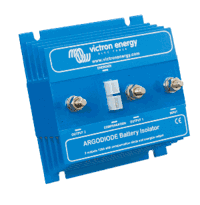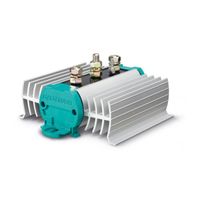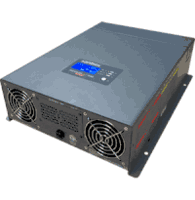 |
 |  |  |
Victron Argodiode Battery Isolator 80-2AC - 2 Batteries - 80A

Brand New with Factory Warranty  |  | Victron Argodiode Battery Isolator 80-2SC - 2 Batteries - 80A

Brand New with Factory Warranty  |
 |
 |
 |  |  |
Victron Argodiode Battery Isolator 140-3AC - 3 Batteries - 140A

Brand New with Factory Warranty  |  | Victron Argodiode Battery Isolator 180-3AC - 3 Batteries - 180A

Brand New with Factory Warranty  |
 |
 |
 |  |  |
Newmar 1-2-120 Isolator 1 alternator, 2 battery banks 120A

Brand New with Factory Warranty  |  | Newmar 1-2-70 Isolator 1 Alternator 2 Bank Battery 70A

Brand New with Factory Warranty  |
 |
 |
 |  |  |
Newmar 1-3-120 Isolator 1 Alternator 3 Bank Battery 120A

Brand New with Factory Warranty  |  | Newmar 1-3-70 Isolator 1 Alternator 3 Bank Battery 70A

Brand New with Factory Warranty  |
 |
 |
 |  |  |
Newmar 2-3-120 Isolator 2 Alternator 3 Bank Battery 120A

Brand New with Factory Warranty  |  | Newmar 2-3-70 Isolator 2 Alternator 3 Bank Battery 70A

Brand New with Factory Warranty  |
 |
 |
 |  |  |
Mastervolt Battery Mate 1602 IG Isolator - 120 Amp, 2 Bank, 83116025

Brand New with Factory Warranty  |  | Mastervolt Battery Mate 1603 IG Isolator - 120A, 3 Bank Battery, 83116035

Brand New with Factory Warranty  |
 |
 |
 |  |  |
Mastervolt Battery Mate 2503 IG Isolator - 200 Amp, 3 Bank Battery, 83125035

Brand New with Factory Warranty  |  | Victron Argo Diode Battery Isolator - 160AMP - 2 Batteries

Brand New with Factory Warranty  |
 |
 |
 |  |  |
Victron Argo FET Battery Isolator - 100AMP - 2 Batteries

Brand New with Factory Warranty  |  | Victron Argo FET Battery Isolator - 200AMP - 2 Batteries

Brand New with Factory Warranty  |
 |
 |
 |  |  |
Victron Argo FET Battery Isolator 200-3 3 Batteries - 200AMP, ARG200301020

Brand New with Factory Warranty  |  | Victron Galvanic Isolator VDI-32A 32A Max Waterproof (Potted), GDI000032000

Brand New with Factory Warranty  |
 |
 |
 |  |  |
Victron Galvanic Isolator VDI-64A 64A Max Waterproof (Potted), GDI000064000

Brand New with Factory Warranty  |  | Victron Argofet Battery Isolator 100-3 3 Batteries - 100AMP

Brand New with Factory Warranty  |
 |
 |
 |  |  |
ProMariner Battery Isolator - 1 Alternator - 2 Battery - 70 AMP

Brand New with Factory Warranty  |  | ProMariner Battery Isolator - 1 Alternator - 3 Battery - 70 AMP

Brand New with Factory Warranty  |
 |
 |
 |  |  |
ProMariner Battery Isolator - 2 Alternator - 2 Battery - 70 AMP

Brand New with Factory Warranty  |  | ProMariner Battery Isolator - 2 Alternator - 3 Battery - 70 AMP

Brand New with Factory Warranty  |
 |
 |
 |  |  |
ProMariner Battery Isolator - 1 Alternator - 2 Battery - 130 AMP

Brand New with Factory Warranty  |  | ProMariner Battery Isolator - 1 Alternator - 3 Battery - 130 AMP

Brand New with Factory Warranty  |
 |
 |
 |  |  |
ProMariner Battery Isolator - 2 Alternator - 2 Battery - 130 AMP

Brand New with Factory Warranty  |  | ProMariner Battery Isolator - 2 Alternator - 3 Battery - 130 AMP

Brand New with Factory Warranty  |
 |
 |
 |  |  |
Victron Galvanic Isolator VDI-16A, 16 AMP Max Waterproof Potted, GDI000016000

Brand New with Factory Warranty  |  | ProMariner ProIsoCharge Battery Isolator 120Amp 1-Alt 2-Bat - 12V

Brand New with Factory Warranty  |
 |
 |
 |  |  |
ProMariner ProIsoCharge 180 Amp Batter Isolator 1 Alternator 2 Batteries

Brand New with Factory Warranty  |  | ProMariner ProIsoCharge 250 Amp Batter Isolator 12v 1 Alternator 2 Batteries

Brand New with Factory Warranty  |
 |
 |
 |  |  |
ProMariner ProIsoCharge Battery Isolator 120Amp 1-Alt 3-Bat - 12V

Brand New with Factory Warranty  |  | ProMariner ProIsoCharge 180 Amp Batter Isolator 12v 1 Alternator 3 Batteries

Brand New with Factory Warranty  |
 |
 |
 |  |  |
ProMariner ProIsoCharge 250 Amp Batter Isolator 12v 1 Alternator 3 Batteries

Brand New with Factory Warranty  |  | ProMariner ProIsoCharge Battery Isolator 130Amp 2-Alt 4-Bat - 12V

Brand New with Factory Warranty  |
 |
 |
 |  |  |
ProMariner ProIsoCharge 150 Amp Battery Isolator 1 Alternator 3 Batteries

Brand New with Factory Warranty  |  | Mastervolt BI1202-S BI Series Battery Isolator 120 Amp 2 Battery

Brand New with Factory Warranty  |
 |
 |
 |  |  |
Mastervolt BI703 BI Series Battery Isolator 70 Amp 3 Battery

Brand New with Factory Warranty  |  | Mastervolt BI702-S BI Series Battery Isolator 70 Amp 2 Battery

Brand New with Factory Warranty  |
 |





































































